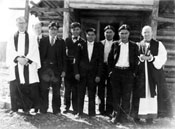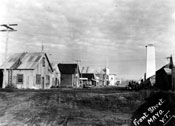 |
back to main story | |
| Mayo - Community Profile | ||
|
The village of Mayo was named after Alfred H. Mayo, a circus acrobat from Maine. He became one of LeRoy 'Jack' Napoleon McQuesten's partners, trading between eastern Alaska on the Yukon River and the Stewart River area prior to the Klondike Gold Rush.
The discovery of gold on the Stewart River in 1883 turned the region into an early prospecting hot spot. Though Mayo has roots in the legendary hunt for Yukon gold, it was the rich silver-ore strike nearby that really propelled the village into prosperity. During the economic slump of the 1920s and '30s, silver strengthened the Yukon's economy. Located at the confluence of the Stewart and Mayo rivers, Mayo also became in important transportation hub in the central Yukon
Mayo Area First Nations

Indian Church board, with Bishop Geddes on the far right, and Reverand Valentine on the far left. ca. 1938
Yukon Archives: #7373
| ||
 |
back to main story | |
